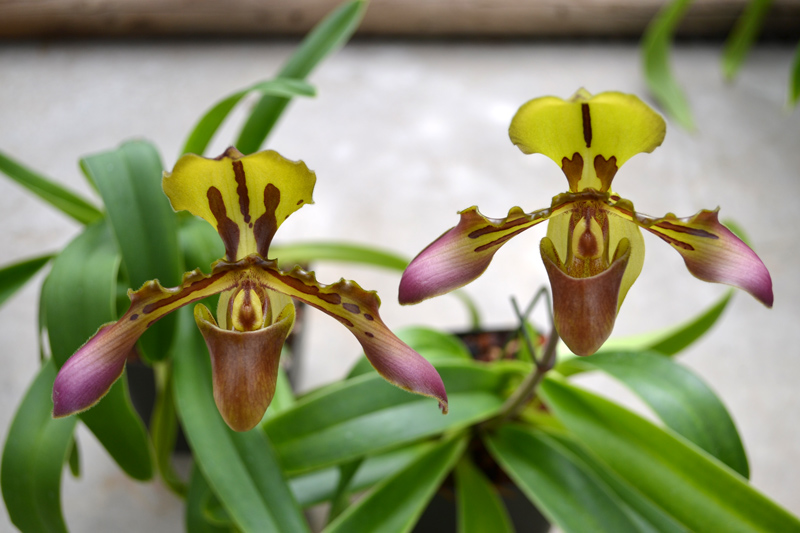The Huntington’s blog takes you behind the scenes for a scholarly view of the collections.
ORCHID COLLECTION | The Huntington visits the San Diego Zoo
Posted on Fri., July 6, 2012 by

Two Paphiopedilum tigrinum plants, donated by the San Diego Zoo, are in bloom in the orchid greenhouse.
Forget the tigers; it is all about the tigrinums. During a visit of Huntington staff and volunteers to the San Diego Zoo in May, the zoo’s Janette Gerrity, senior orchid specialist, and Michael Bostwick, curator of horticulture, donated three Paphiopedilum tigrinum plants to The Huntington. These P. tigrinum plants are not just any ordinary plants. This species is hard to find. If you do manage to locate one, you may not be able to afford it.
From a conservation perspective, Paphiopedilum tigrinum is one of the harder species to germinate in the lab. It is hard for the seeds to germinate because they require very specific conditions, whereas most other paphiopedilums are not so picky. Consequently, we see very few P. tigrinum plants in captivity. Nonetheless, a mature, blooming P. tigrinum usually will grow like a weed and is actually one of the easier species to maintain.
The Huntington treasures this donation since it gives us an opportunity to explore ways to germinate this species more easily. Ultimately, we can then make it more accessible to the orchid community. P. tigrinum was introduced in 1990 by Norito Hasegawa and Harold Koopowitz, two of our greatest orchid experts in Southern California. In nature it can be found in the Gaoligong Mountains and the Salween River gorge, bordering Burma and China, between 4,500 and 6,500 feet in elevation.
On June 21, 2012, two of our new plants bloomed. We immediately made a sibling cross, a process where we take pollen from one flower and place it on another flower of a separate clone. We are crossing our fingers and hope the flower will accept the pollen so that we can germinate them in a year when the seed pod is finally ready.
As for the San Diego Zoo, its botanical collection consists mostly of orchid species with a large emphasis on Paphiopedilums. From Paphiopedilum sanderianum to Laelia purpurata, they seem to have it all. Janette Gerrity, who curates the collection, gave us a personal tour of the facilities and of the zoo grounds, mixing both plants and animals in an exciting adventure. We also had the privilege of seeing their laboratory, where Christy Powell, the plant propagator, showed us her operation.
If you are interested in visiting the San Diego Zoo’s orchid collection (discussed in an earlier blog post here), the zoo hosts an open house called “The Orchid Odyssey” on the third Friday of every month; visitors can visit the greenhouse and interact with an orchid specialist. The program runs from 10 a.m. to 2 p.m. and is free with the price of admission.
Brandon Tam is The Huntington's orchid specialist.